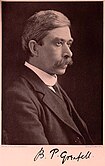Papyrus 10
Oxyrynchus, Egypt | |
| Now at | Houghton Library |
|---|---|
| Cite | Grenfell & A. S. Hunt, Oxyrhynchus Papyri II (1899), pp. 8-9 |
| Size | 25.1 x 19.9 |
| Type | Alexandrian text-type |
| Category | I |
Papyrus 10 (in the
Description
The manuscript is a fragment of one leaf, written in one column per page. The surviving text is of Romans, verses 1:1-7. The manuscript was written very carelessly. The handwriting is crude and irregular, and the copy contains some irregular spellings. A part of verse 6 is omitted (εν οις εστε και υμεις κλητοι who are called to belong to).[2]
The nomina sacra are written in an abbreviated way.
The Greek text of this codex is a representative of the Alexandrian text-type. Aland placed it in Category I.[1] The manuscript is too brief for certainty. The only variant of any importance is Χριστου Ιησου in Rom 1:7, where the manuscripts all have the reverse order.[3]
History
The papyrus was found tied up with a contract dated in 316 A.D., and other documents of the same period.[2]
It was discovered in
See also
- List of New Testament papyri
- Oxyrhynchus papyri
- Papyrus 9
- Papyrus Oxyrhynchus 208
- Papyrus Oxyrhynchus 210
- Romans 1
References
- ^ ISBN 978-0-8028-4098-1.
- ^ a b B. P. Grenfell & A. S. Hunt, Oxyrhynchus Papyri II (1899), p. 8.
- ^ B. P. Grenfell & A. S. Hunt, Oxyrhynchus Papyri II (1899), p. 9.
- ^ "Handschriftenliste". Münster: Institute for New Testament Textual Research. Retrieved 23 August 2011.
Further reading
- B. P., Grenfell; Hunt, A. S. (1899). Oxyrhynchus Papyri II. London: Egypt Exploration Fund. pp. 8–9.
- C. R. Gregory, "Textkritik des Neuen Testaments", Leipzig 1909, vol. 3, p. 1091.
- Gregory, Caspar René (1908). Die griechischen Handschriften des Neuen Testament. Leipzig: J.C. Hinrichs’sche Buchhandlung. p. 46.


